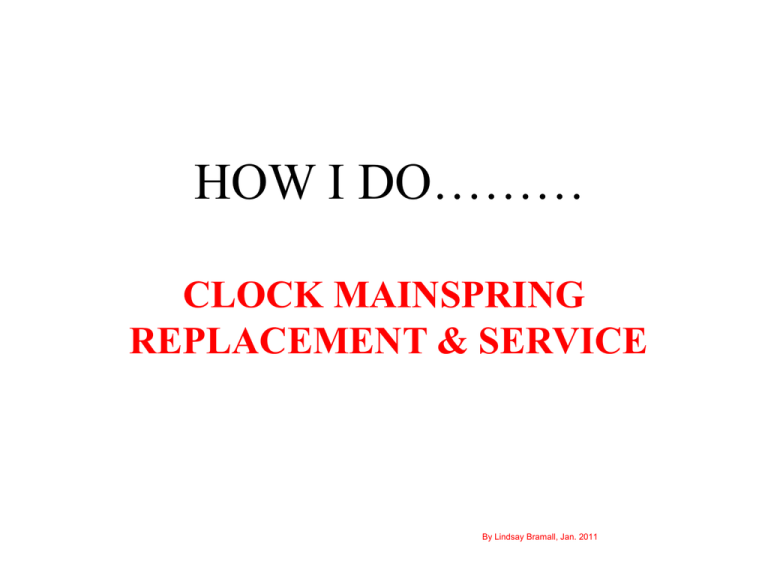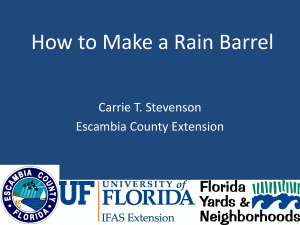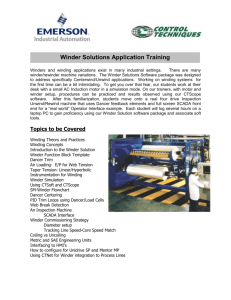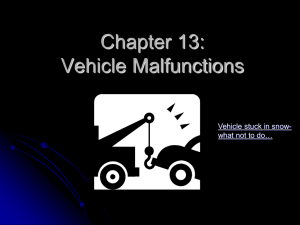Lathe as a mainspring winder.
advertisement

HOW I DO……… CLOCK MAINSPRING REPLACEMENT & SERVICE By Lindsay Bramall, Jan. 2011 Open and enclosed mainsprings. TOOLS. Open mainspring clamps Let-down keys English style mainspring winders. Lock Spring outer end clamp Clamp bar Barrels 30mm to 60 mm ID Winding arbor Barrels below 30mm ID Mainspring winders offer safe, controlled manipulation of mainsprings and do not induce “coning” as does winding in/out of barrels by hand. Unlocked and free to rotate for winding and de-winding springs Winder locked to hold the wound up mainspring whilst a barrel is removed or replaced. Lathe as a mainspring winder. ( Another method for open springs ) Well used heavy leather glove. Spring cleaning board Gas torch Hole punch Step 1. “LETTING DOWN” THE MAINSPRING Remove the click spring and fit the let-down key Hold the movement, take the spring force with the key and let the power down. Fit the let-down key and wind up the spring until…. ….the clamp drops on. With the spring tension under the control of the hand held let-down key, release the click spring and click and…. ….let the spring down into the clamp. Springs secured and removed from the movement Springs ready to remove for cleaning or replacement. Step 2. REMOVING THE MAINSPRING ( DE-WINDING ) a. Enclosed b. Open Clamp for spring outer end. “Safe mode” lock Mainspring inner hook Firmly lock the winder in a bench vice. a. Enclosed mainsprings ( de-winding ) Present the mainspring and engage the inner hole on the winder arbor hook Drop the clamp bar into the top of the winder and insert the open clamp tongue into the outer coil about 20mm from the hook. Tighten the clamp to grip the spring. Grip the barrel tightly and wind up the mainspring until the outer coil can be seen on the barrel hook. Clamp bar is locked securely by the two forks. The winding arbor is locked safely here All spring force is now being taken by the winder and the barrel may be removed. Barrel off and spring now ready to be de-wound. Note the “coning” induced when this spring was previously hand wound into the barrel ! Controlled unlocking of the winder and de-winding of the mainspring. b. Open mainsprings ( de-winding ) Engage the winder clamp adjacent to the loop and insert the winding arbor and hook the centre hole. Winding arbor locked and the mainspring clamp removed. Spring now ready to be wound up to release the mainspring clamp. Spring de-wound for servicing or discarding All spring force now taken by the winder ready to de-wind. Step 3. SERVICING THE EXISTING, OR NEW, MAINSPRING BEFORE FITTING Only use the old mainspring if it has not lost its strength or shape. Thoroughly clean all mainsprings with solvent and for reuse of existing springs clean with fine steel wool or 2000 grit “wet & dry” paper, then clean with solvent. Repair the end hole if required. Punch a new hole and shape to suit the barrel hook New end shaped to fit the barrel hook Punch & die Step 4. SIZING THE MAINSPRING • You cannot assume that the old spring was correct for the barrel. • Measure the depth of the barrel from the cap lip to the bottom of the barrel. Subtract 0.5 to 1.0 mm to give the correct spring height. • Use the “hundredth rule” to estimate the spring gauge. ie. a barrel ID of 30 mm will use a 0.3 mm thick spring. A 45mm ID barrel will need a 0.45mm thick spring. • Measure the barrel ID. and the arbor OD. Using these measurements and the spring gauge calculate the spring length using : (0.393 x ((bID x bID) - (aOD x aOD))) / sGauge Mainspring calculatorI.xls • Compare these measurements to the old spring. • Order a new spring by: Height x guage x length ( or barrel ID) ie. 22 mm x 0.45mm x 1680mm ( 45mm ID ) Step 5. REPLACING THE MAINSPRING Smear the full length of the spring, the cleaned barrel interior and the barrel arbor pivots with oil, then… simply reverse the removal processes. WINDING OPEN SPRINGS DIRECTLY ONTO ( OR OFF ) THEIR ARBOR IN A LATHE. Engage the spring centre hole on the arbor hook and the outer loop on a long rod in the tool holder. Grip the arbor up against the wheel. Rotate the chuck by hand to wind the spring onto the arbor. Loop engaged on the rod in the tool post Continue to rotate the chuck until the clamp will fit over the spring, then let go of the chuck and the spring will run back into the clamp. Withdraw the rod and the spring is now ready to refit to the movement. SIMPLE ISN’T IT ? These are my methods, however, there are many others, equally as good. This is the most dangerous operation in clock repair so have good tools, safe methods and keep the eyes and mind focused on the job. Things can go awfully wrong in a split second !!!








